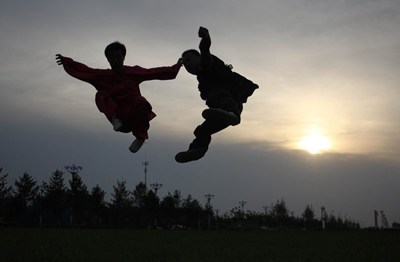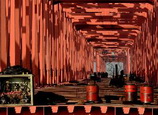
 |
| (Photo/Xinhua) |
"I used to practice right by the canal when I was a child," master Ma recalls. "When I was in my teens, the canal was still very crowded with cargo ships and sailors working on the boats. An entire district is called the canal district. I remember seeing ships as late as the 1970s."
He even remembers the sailors songs that he used to hear all the time back then. He bursts into song:
"Turning and turning along the canal, twisting, twisting we go forward. Ah hei yo, I sing with sweat. Ah hei yo, I sing with courage ..."
Those lines are just a few from the many songs sailors sang as they worked their barges and ships. There were different work songs for different positions, such as fore and aft, and various jobs. Many old residents in the canal district can still sing a few lines, like Ma.
As in many northern cities, sluice gates are closed at the city's border to maintain the water level of the unused downtown canal, which is being turned into a tourist attraction. The water has been cleaned, river banks have been landscaped, decorative lights have been installed and sightseeing boats are expected to ply the waters.
"I haven't visited the renovated canal, but I can imagine how nostalgic it will be for me," martial arts master Ma says. "I must try to practice martial arts there at least once."
Ma is master of a dozen martial arts forms, which is not uncommon for Cangzhou locals. Many schools teach martial arts as exercise. One of the most popular forms is called pi gua quan, which literally means "chop hanging fist."
"Beware. It's a rather wild and explosive style of martial arts," says Wang, another master and coach from the martial arts association. He is best known for the chop hanging fist.
"What do you mean by explosive?" I ask.
Wang clears a space around himself, of around two meters.
Bang, bang, bang ...
Without realizing what is happening, I feel the air rushing past and see Wang's arms whipping as though they are not attached to his body. He is around 1.7m tall, but at that moment, his arms seem like those of a person of 1.8m or 1.9m.
"This is just the very basic first movement of the fist," he says calmly, like an entirely different person from the human windmill I just witnessed.
"The point is to extend your reach further than your enemy could ever anticipate," Wang says, showing his secret, his joints.
They seem to have been broken or impossibly stretched. I touch a round depression on his shoulder joint - he could place an egg there.
"Almost all the masters you have read about came from Cangzhou and learned their techniques in Cangzhou," Wang concludes. "Then, in the old times, they traveled, often by canal, to different places to chuang ma tou."
Cangzhou City
Location: The city is in the east of Hebei Province, about 100km from Tianjin and 200km from Beijing.
Many Chinese have first learned about the place from "Water Margin," one of the four great classic novels of Chinese literature. The fiction depicts lives of 108 outlaws in the Song Dynasty (960-1279) and Cangzhou appears as a deserted area where prisoners were sent in exile.
It remains debatable whether the Cangzhou in the novel refers to the current city, but today's Cangzhou is far from the wasteland depicted in the novel. The city, near the ocean, is close to the economically developed Tianjin and capital city of Beijing. It is also rich in resources including oil, natural gas and salt.















 Pretty model shines at Guangzhou Auto Show Hyundai Motor stage
Pretty model shines at Guangzhou Auto Show Hyundai Motor stage


![]()
